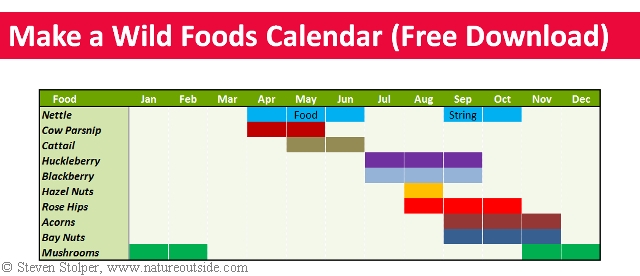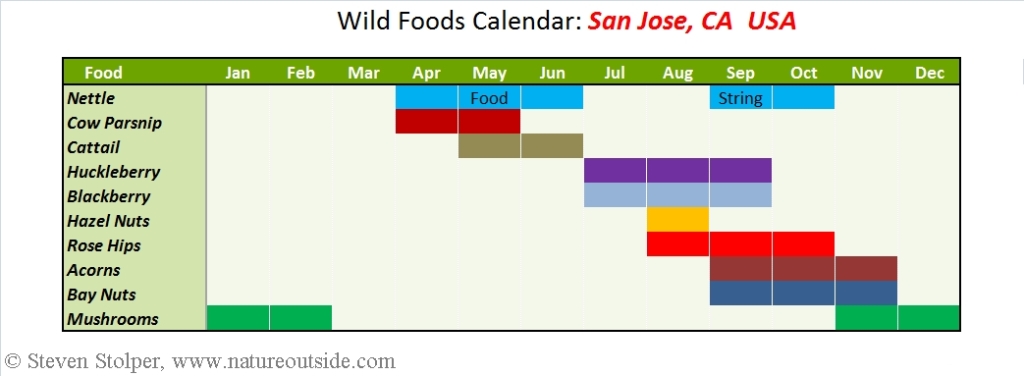
Eating wild edibles is like having a time machine.
I don’t mean it will prolong your life. I’ll let journal articles tell you that.
I mean it’s like having a time machine!
The Twin Paradox
Are you familiar with Einstein’s theory of relativity? Neither am I.
The theory holds that as your velocity approaches the speed of light, time slows down for you compared to the rest of the universe.
In one of his famous thought experiments, Einstein separates two identical twins. One blasts off into space on a very fast rocket. Traveling near the speed of light, the twin returns to Earth unchanged many years later. He finds his brother is an old man! Time passed without him realizing because he was traveling so fast.
Our Modern Paradox
The way we rush around in our modern lives you would think we were the ones traveling at the speed of light. But unlike Einstein’s astronaut twin, we wake one morning to find that we are the old ones! The best years of our lives evaporated without notice.
What Time is it, Really?
One reason why this happens is that we have lost touch with time. I don’t mean that we can’t read a wristwatch. I mean we have lost our connection to the physical passage of time in our universe.
Try this quiz:
- How many years have you been alive?
- How many times have you seen the sun rise?
Night and day are optional now. We are completely disconnected from the physical cycles of our world. We stay up as late as we want and we rise whenever the alarm clock wakes us. As a result many of us walk around perpetually sleep-deprived.
Think how different your life would be if every electric light on the planet disappeared. You would rise with the sun and sleep when it’s dark. The long summer days and the long winter nights would have real meaning. You would mark the passage of time because your life was interwoven with the Earth’s natural cycles.
Connecting with Time
Wild foods calendars connect us to the passage of time. We notice the leaves turning, the snow thawing, the flowers blooming, and the berries ripening. We harvest acorns in autumn, delicious greens in spring, seeds in the summer, and berries again as the days get shorter.
Harvesting wild edibles joins us to Earth’s natural cycles. Each season brings its own joys: acorns, rose hips, elderflowers, and huckleberries. The “seasonal round” wakes us to the passage of time that otherwise escapes our notice. This mindfulness is like having a time machine. By perceiving time, we live more of it!
Did I mention the Yummies?
Of course, there is a practical side to keeping a wild foods calendar. Knowing when to look for local delicacies ensures there is always a delectable treat on your table. I use my wild foods calendar to plan my hikes, my harvests, and my menus. It reminds me what’s in season so I can keep an eye out for a particular resource. Most of all, I keep a wild foods calendar because it’s fun!
Calendar Made Simple
It’s easy to make a wild foods calendar. I start by going for a hike. I notice what is growing, blooming and fruiting. When I get home, I mark it down in a visual way.
I use a Microsoft Excel spreadsheet. Here’s a sample from my calendar.
The calendar is specific to an area or region. This is because the species that grow and the time of year they provide food are location specific. In the left column, I list the name of the resource. Then I move across the row, setting the background color for cells in the columns of the months they provide food. If a resource provides different resources at different times of year, I type text into the cells to remind me what to look for. For example, Stinging nettles provide greens in spring and bast fibres for cordage in autumn.
You don’t have to limit your calendar put to just plants! I love to observe wildlife. And I happen to live near one of the few Elephant Seal colonies in the northern hemisphere. So my calendar reminds me that the best time to see elephant seals at Ano Nuevo is November to March (not shown in the picture above). During these times, you need to hike with a guide to keep from being flattened. So the calendar reminds me to make a reservation to visit during these prime viewing months.
Free Download
Here is the blank spreadsheet I use to create my calendars. Feel free to download it and customize it for your needs.
Click to Download the Wild Foods Calendar Excel Spreadsheet
If you Email me using the contact sheet of this website, I will send you an Email address you can use to send me your calendars. In a future post I will share calendars created by NatureOutside readers. So send me your calendars!
Other Wild Edibles on NatureOutside
How to Make Acorns into Food (Part 1)
See the Edibles Section for more articles about wild edibles.




Leave a Comment